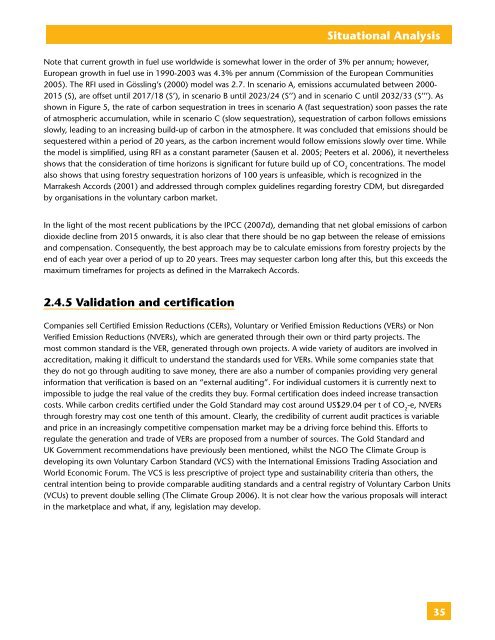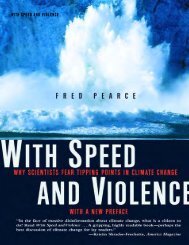Tourism & CC Challenges & Opportunities - Global Commons Institute
Tourism & CC Challenges & Opportunities - Global Commons Institute
Tourism & CC Challenges & Opportunities - Global Commons Institute
You also want an ePaper? Increase the reach of your titles
YUMPU automatically turns print PDFs into web optimized ePapers that Google loves.
Situational Analysis<br />
Note that current growth in fuel use worldwide is somewhat lower in the order of 3% per annum; however,<br />
European growth in fuel use in 1990-2003 was 4.3% per annum (Commission of the European Communities<br />
2005). The RFI used in Gössling’s (2000) model was 2.7. In scenario A, emissions accumulated between 2000-<br />
2015 (S), are offset until 2017/18 (S’), in scenario B until 2023/24 (S’’) and in scenario C until 2032/33 (S’’’). As<br />
shown in Figure 5, the rate of carbon sequestration in trees in scenario A (fast sequestration) soon passes the rate<br />
of atmospheric accumulation, while in scenario C (slow sequestration), sequestration of carbon follows emissions<br />
slowly, leading to an increasing build-up of carbon in the atmosphere. It was concluded that emissions should be<br />
sequestered within a period of 20 years, as the carbon increment would follow emissions slowly over time. While<br />
the model is simplified, using RFI as a constant parameter (Sausen et al. 2005; Peeters et al. 2006), it nevertheless<br />
shows that the consideration of time horizons is significant for future build up of CO 2<br />
concentrations. The model<br />
also shows that using forestry sequestration horizons of 100 years is unfeasible, which is recognized in the<br />
Marrakesh Accords (2001) and addressed through complex guidelines regarding forestry CDM, but disregarded<br />
by organisations in the voluntary carbon market.<br />
In the light of the most recent publications by the IP<strong>CC</strong> (2007d), demanding that net global emissions of carbon<br />
dioxide decline from 2015 onwards, it is also clear that there should be no gap between the release of emissions<br />
and compensation. Consequently, the best approach may be to calculate emissions from forestry projects by the<br />
end of each year over a period of up to 20 years. Trees may sequester carbon long after this, but this exceeds the<br />
maximum timeframes for projects as defined in the Marrakech Accords.<br />
2.4.5 Validation and certification<br />
Companies sell Certified Emission Reductions (CERs), Voluntary or Verified Emission Reductions (VERs) or Non<br />
Verified Emission Reductions (NVERs), which are generated through their own or third party projects. The<br />
most common standard is the VER, generated through own projects. A wide variety of auditors are involved in<br />
accreditation, making it difficult to understand the standards used for VERs. While some companies state that<br />
they do not go through auditing to save money, there are also a number of companies providing very general<br />
information that verification is based on an “external auditing”. For individual customers it is currently next to<br />
impossible to judge the real value of the credits they buy. Formal certification does indeed increase transaction<br />
costs. While carbon credits certified under the Gold Standard may cost around US$29.04 per t of CO 2<br />
-e, NVERs<br />
through forestry may cost one tenth of this amount. Clearly, the credibility of current audit practices is variable<br />
and price in an increasingly competitive compensation market may be a driving force behind this. Efforts to<br />
regulate the generation and trade of VERs are proposed from a number of sources. The Gold Standard and<br />
UK Government recommendations have previously been mentioned, whilst the NGO The Climate Group is<br />
developing its own Voluntary Carbon Standard (VCS) with the International Emissions Trading Association and<br />
World Economic Forum. The VCS is less prescriptive of project type and sustainability criteria than others, the<br />
central intention being to provide comparable auditing standards and a central registry of Voluntary Carbon Units<br />
(VCUs) to prevent double selling (The Climate Group 2006). It is not clear how the various proposals will interact<br />
in the marketplace and what, if any, legislation may develop.<br />
35
















